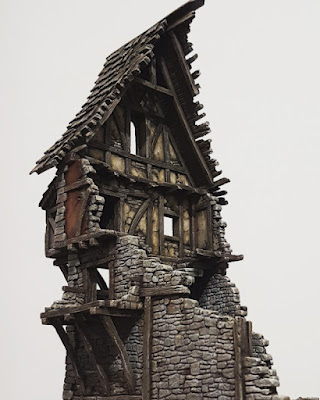Since I started playing Warhammer Fantasy Battles, somewhere around 1998, I was always into tabletop scenery. When I came across the terrain section of the Empire Army Book (6th edition Warhammer), showing examples of the scratch built buildings, I was immediately inspired to make some terrain pieces for my own gaming table. My friends didn't care to much about terrain, they just wanted to play. I remember we even used books for the hills. :) I was on the other hand always drawn to the visual side. You could say they were purely gamers while I was more into painting and crafting side of the hobby. I find the game so much more immersive and appealing when you have decent scenery on your tabletop, be it natural features or buildings. I always found myself getting to the eye level of my miniatures and checking out surroundings, feeling like I'm there in the fantasy world or in the middle of the action. :)
Through my years in the hobby I have built plenty models from scratch and painted a lot of terrain pieces made by different companies. The beginnings were humble, I was making small structures like hobbit holes or trees made of bottle cleaners, but with time the projects became more challenging and complex. However, I newer tried building something out of the XPS foam. Having seen some inspiring videos on YouTube I felt there was a lot of potential in the material, so about a year ago I decided to give it a go.
For my first project made in XPS foam I decided to do a Ruined Townhouse which would fit nicely on my friend's Mordheim table. I did some basic sketches but the building was pretty straightforward and I didn't think too much about the design and made decisions and changes as I was crafting it. I did however think about gameplay, making sure that the floors are high enough to fit most of the miniatures and that there is enough openings for models to shoot and move through, as well as places to hide.
For cutting bigger pieces of foam I used Proxxon Thermocutter. I strongly
advise buying this piece of equipment if you are serious about making
terrain out of XPS foam. It allows you to make perfect and clean cuts. For gluing pieces together I started by using a glue gun but this showed to be pretty messy so I switched to PVA glue which turned out to be perfect for this kind of material. Before gluing different wall sections together I was considering how easy will it be to carve the surfaces after gluing. If I saw that some of the sections would be hard to reach, I would carve them first and then glue them in place.
I found the ball pen carving technique really intuitive and easy to master. The only thing I regret is using a blue ink pen. Later on this proved to be a mistake. Blue ink got mixed with grey acrylic paint making the greys bluish which was quite frustrating. If it was a black ink pen, it wouldn't matter.
Once the build was finished, my main concern was fragility of the XPS foam. Thin parts, like protruding beams, can easily snap if the players are not careful enough when moving their hands around the structure. In order to seal the foam and make it as hard as possible I used watered down PVA glue and gave the whole model a rich coat.
When this dried completely I started to paint the model. I immediately realized how nicely acrylic paint adheres to the foam.
Once the paintjob was finished I added some grass tufts, dead leaves and moss, to give it even more deteriorating and abandoned look. All in all, I am happy with the result, especially considering this was my first try in making terrain out of XPS foam.
In the near future I plan to make an in-depth tutorial showing the techniques I used to make this Ruined Townhouse.
Cheers guys! 🍻

















its just stunning in awe of your foam carving i really must give it a try , did you ever create the tutorial for this ?
ReplyDeleteThank you for your kind words! :)
DeleteNot yet, but I plan to create it in the near future.
Can't wait for tutorial :) I suppose you use these techniques when you fill out with scratch built parts for your tabletop world buildings conversions?
ReplyDeleteThanks! :) No, when I convert resin kits I only use resin and plastic parts. At least for now.
DeleteThis looks great! Found it trough pinterest and I'm trying to figure out what sizes of XPS foam you used. Are you still planning on making a tutorial? Thanks!
ReplyDeleteThank you! :) The foam is 60x100x10 cm but I cut it with my proxxon to be about 8 mm thick. I do plan to do tutorial but honestly I don't know when will I find time to do it. Some time in the future definitely.
DeleteReally great result! I’m curious— for the plaster effect, is that carved into the same piece as the stones, or a second layer of foam glued on after? Same for the corner stones that protrude out further
ReplyDeleteThanks! The plaster is done in the same piece of foam as stone. The foam were the stone is is pushed a little bit inwards before carving. That way the plaster look realistic, like it's covering stone.
DeleteThe corner stones are separate foam pieces cut in L shape and then glued to the corner.
Hope this helps. :)
Do you have any hire resolution photos? Your painting style is a big inspiration for my own terrain project im working on.
ReplyDelete